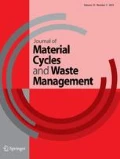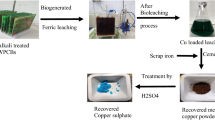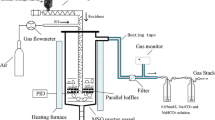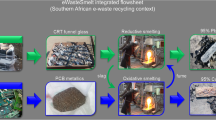Abstract
In this paper, a detailed thermodynamic analysis of processing of electronic waste (e-waste), particularly printed circuit boards (PCB), through secondary copper recycling (black copper smelting), was carried out. The mass balance flowsheets of two scenarios, i.e., the case of secondary copper recycling with (SCE1) and without (SCE2) addition of PCBs, have been developed and compared. From the perspective of recovery of copper (Cu), gold (Au), and silver (Ag); the thermodynamic analysis predicted that the process conditions at temperature of 1300 °C and oxygen partial pressure (pO2) of 10–8 atm are suitable for PCB processing through secondary copper smelting route. Under these conditions, no solid phases were predicted to form when the PCB addition is below 50 wt%. High PCB addition was predicted to produce high volume of slag in the process and more pollutants in the gas phase (Br-based gaseous compounds). The chemistry of the slag was also predicted to change that is shifting the liquidus temperature to a higher value due to the presence of aluminium (Al), silica (SiO2), and titanium dioxide (TiO2) in the feed coming from the PCB. The carbon content of the PCB potentially supplies additional heat and reductant (CO) in the process hence can partially replace coke in the feed material. The predicted recoveries of copper (Cu), gold (Au), and silver (Ag) from e-waste were 83.3, 96.5, and 88.5 wt% respectively.




















Similar content being viewed by others
References
Xue M, Kendall A, Xu Z, Schoenung JM (2015) Waste management of printed wiring boards: a life cycle assessment of the metals recycling chain from liberation through refining. Environ Sci Technol 49:940–947. doi:10.1021/es504750q
Heacock M, Kelly CB, Suk WA (2016) E-waste: the growing global problem and next steps. Rev Environ Health 31:131–135
Davenport WGL, King M, Schlesinger M, Biswas AK (2002) Extractive metallurgy of copper. Pergamon Press, Oxford
Institute of Scrap Recycling Industries (ISRI) (2003) Scrap recycling: where tomorrow begins. ISRI, Washington, DC, pp 16–24
Anindya A, Swinbourne DR, Reuter MA, Matusewicz RW (2013) Distribution of elements between copper and FeO x –CaO–SiO2 slags during pyrometallurgical processing of WEEE. Miner Process Extr Metall 122:165–173. doi:10.1179/1743285513Y.0000000043
Hoffmann JE, n.d. Recovering precious metals from electronic scrap. JOM 44:43–48. doi:10.1007/BF03222275
Sun J, Wang W, Liu Z, Ma C (2011) Recycling of waste printed circuit boards by microwave-induced pyrolysis and featured mechanical processing. Ind Eng Chem Res 50:11763–11769. doi:10.1021/ie2013407
Ghodrat M, Rhamdhani MA, Brooks G, Masood S, Corder G (2016) Techno economic analysis of electronic waste processing through black copper smelting route. J Clean Prod. doi:10.1016/j.jclepro.2016.03.033
Davis G, Herat S (2008) Electronic waste: The local government perspective in Queensland, Australia. Resour. Conserv. Recycl 52:1031–1039. doi:10.1016/j.resconrec.2008.04.001
Golev A, Schmeda-Lopez DR, Smart SK, Corder GD, McFarland EW (2016) Where next on e-waste in Australia? Waste Manag 58:348–358. doi:10.1016/j.wasman.2016.09.025
EEA (2013) Managing municipal solid waste—a review of achievements in 32 European countries. EEA Report No 2/2013, European Environment Agency
Randell P, Pickin J, Grant B, (2014) Waste Generation and Resource Recovery in Australia. Blue Environment Pty Ltd; Department of Sustainability, Environment, Water, Population and Communities. http://www.environment.gov.au/resource/waste-generation-and-resource-recovery-australia-report-anddata-workbooks. Available online.
Khaliq A, Rhamdhani MA, Brooks G, Masood S (2014) Metal extraction processes for electronic waste and existing industrial routes: a review and Australian perspective. Resources 3:152–179. doi:10.3390/resources3010152
Nakajima K, Takeda O, Miki T, Matsubae K, Nakamura S, Nagasaka T (2010) Thermodynamic analysis of contamination by alloying elements in aluminum recycling. Environ Sci Technol 44:5594–5600. doi:10.1021/es9038769
Castro MBG, Remmerswaal JAM, Reuter MA, Boin UJM (2004) A thermodynamic approach to the compatibility of materials combinations for recycling. Resour Conserv Recycl 43:1–19. doi:10.1016/j.resconrec.2004.04.011
Worrel E, Reuter MA (2014) Handbook of recycling. Elsevier BV, Amsterdam, 595 p
Recalde K, Wang J, Graedel TE (2008) Aluminium in-use stocks in the state of Connecticut. Resour Conserv Recycl 52:1271–1282. doi:10.1016/j.resconrec.2008.07.006
Nakajima K, Yokoyama K, Nagasaka T (2008) Substance flow analysis of manganese associated with iron and steel flow in Japan. ISIJ Int 48:549–553. doi:10.2355/isijinternational.48.549
Wang T, Müller DB, Graedel TE (2007) Forging the anthropogenic iron cycle. Environ Sci Technol 41:5120–5129. doi:10.1021/es062761t
Graedel TE, Bertram M, Kapur A, Reck B, Spatari S (2004) Exploratory data analysis of the multilevel anthropogenic copper cycle. Environ Sci Technol 38:1253–1261. doi:10.1021/es0304345
Johnson J, Schewel L, Graedel TE (2006) The contemporary anthropogenic chromium cycle. Environ Sci Technol 40:7060–7069. doi:10.1021/es060061i
Ayres R, Talens Peiró L (2013) Material efficiency: rare and critical metals. Phil Trans R Soc A 371:20110563. doi:10.1098/rsta.2011.0563
Wu Y, Yin X, Zhang Q, Wang W, Mu X (2014) The recycling of rare earths from waste tricolor phosphors in fluorescent lamps: A review of processes and technologies. Resour Conserv Recycl 88:21–31. doi:10.1016/j.resconrec.2014.04.007
Binnemans K, Jones PT (2014) Perspectives for the recovery of rare earths from end-of-life fluorescent lamps. J Rare Earths 32:195–200. doi:10.1016/S1002-0721(14)60051-X
Van Eygen E, De Meester S, Tran HP, Dewulf J (2016) Resource savings by urban mining: the case of desktop and laptop computers in Belgium. Resour Conserv Recycl 107:53–64. doi:10.1016/j.resconrec.2015.10.032
Oguchi M, Murakami S, Sakanakura H, Kida A, Kameya T (2011) A preliminary categorization of end-of-life electrical and electronic equipment as secondary metal resources. Waste Manag 31:2150–2160. doi:10.1016/j.wasman.2011.05.009
Guo C, Wang H, Liang W, Fu J, Yi X (2011) Liberation characteristic and physical separation of printed circuit board (PCB). Waste Manag 31:2161–2166. doi:10.1016/j.wasman.2011.05.011
Yamane LH, de Moraes VT, Espinosa DCR, Tenório JAS (2011) Recycling of WEEE: Characterization of spent printed circuit boards from mobile phones and computers. Waste Manag 31:2553–2558. doi:10.1016/j.wasman.2011.07.006
Li J, Lu H, Guo J, Xu Z, Zhou Y (2007) Recycle technology for recovering resources and products from waste printed circuit boards. Environ Sci Technol 41:1995–2000. doi:10.1021/es0618245
Rath SS, Nayak P, Mukherjee PS, Roy Chaudhury G, Mishra BK (2012) Treatment of electronic waste to recover metal values using thermal plasma coupled with acid leaching—a response surface modeling approach. Waste Manag 32:575–583. doi:10.1016/j.wasman.2011.11.001
Bhat V, Rao P, Patil Y (2012) Development of an integrated model to recover precious metals from electronic scrap—a novel strategy for E-Waste management. Procedia Soc Behav Sci 37:397–406. doi:10.1016/j.sbspro.2012.03.305
Syed S (2012) Recovery of gold from secondary sources—a review. Hydrometallurgy 115–116:30–51. doi:10.1016/j.hydromet.2011.12.012
Kim E, Kim M, Lee J, Pandey BD (2011) Selective recovery of gold from waste mobile phone PCBs by hydrometallurgical process. J Hazard Mater 198:206–215. doi:10.1016/j.jhazmat.2011.10.034
Robinson BH (2009) E-waste: an assessment of global production and environmental impacts. Sci Total Environ 408:183–191. doi:10.1016/j.scitotenv.2009.09.044
Sepúlveda A, Schluep M, Renaud FG, Streicher M, Kuehr R, Hagelüken C, Gerecke AC (2010) A review of the environmental fate and effects of hazardous substances released from electrical and electronic equipments during recycling: examples from China and India. Environ Impact Assess Rev 30:28–41. doi:10.1016/j.eiar.2009.04.001
Frazzoli C, Orisakwe OE, Dragone R, Mantovani A (2010) Diagnostic health risk assessment of electronic waste on the general population in developing countries’ scenarios. Environ Impact Assess Rev 30:388–399. doi:10.1016/j.eiar.2009.12.004
Xing GH, Chan JKY, Leung AOW, Wu SC, Wong MH (2009) Environmental impact and human exposure to PCBs in Guiyu, an electronic waste recycling site in China. Environ Int 35:76–82. doi:10.1016/j.envint.2008.07.025
Grant K, Goldizen FC, Sly PD, Brune MN, Neira M, van den Berg M, Norman RE (2013) Health consequences of exposure to e-waste: a systematic review. Lancet Glob Heal 1:e350–e361. doi:10.1016/S2214-109X(13)70101-3
Barba-Gutiérrez Y, Adenso-Díaz B, Hopp M (2008) An analysis of some environmental consequences of European electrical and electronic waste regulation. Resour Conserv Recycl 52:481–495. doi:10.1016/j.resconrec.2007.06.002
Tsydenova O, Bengtsson M (2011) Chemical hazards associated with treatment of waste electrical and electronic equipment. Waste Manag 31:45–58. doi:10.1016/j.wasman.2010.08.014
Yamasue E, Minamino R, Numata T, Nakajima K, Murakami S, Daigo I, Hashimoto S, Okumura H, Ishihara KN (2009) Novel evaluation method of elemental recyclability from urban mine—concept of urban ore TMR. Mater Trans 50:1536–1540. doi:10.2320/matertrans.MBW200816
Agrawal A, Sahu KK (2010) Problems, prospects and current trends of copper recycling in India: an overview. Resour Conserv Recycl 54:401–416. doi:10.1016/j.resconrec.2009.09.005
Kang HY, Schoenung JM (2005) Electronic waste recycling: a review of U.S. infrastructure and technology options. Resour Conserv Recycl 45:368–400. doi:10.1016/j.resconrec.2005.06.001
Anindya A, 2012. Minor Elements Distribution during the Smelting of WEEE with Copper Scrap. RMIT University
Rentz O, Krippner M, Hähre S, Schultmann F (1999) Report on best available techniques (BAT) in copper production. Deutsch-Französisches Inst. für Umweltforsch. Univ. Karlsruhe (TH), Karlsruhe, Ger
Nolte A (1997) Metallurgical utilization of reusable products from the recycling industry in a secondary copper smelter. In: EPD Congress 1997, pp 377–400
Traulsen HR, Taylor JC, George DB (1982) Copper smelting—an overview. JOM 34:35–40. doi:10.1007/BF03338071
Shuva MAH, Rhamdhani MA, Brooks GA, Masood S, Reuter MA (2016) Thermodynamics behaviour of Germanium during equilibrium reactions between FeO x –CaO–SiO2–MgO slag and molten copper. Metall Mater Trans B 47(5):2889–2903
Shuva MAH, Rhamdhani MA, Brooks GA, Masood SH, Reuter MA (2016) Thermodynamics of palladium (Pd) and tantalum (Ta) relevant to secondary copper smelting. Metall Materi Trans B. doi:10.1007/s11663-016-0839-y
Shuva MAH, Rhamdhani MA, Brooks GA, Masood S, Reuter MA (2016) Thermodynamics data of valuable elements relevant to e-waste processing through primary and secondary copper production: a review. J Clean Prod 131:795–809
Author information
Authors and Affiliations
Corresponding author
Rights and permissions
About this article
Cite this article
Ghodrat, M., Rhamdhani, M.A., Khaliq, A. et al. Thermodynamic analysis of metals recycling out of waste printed circuit board through secondary copper smelting. J Mater Cycles Waste Manag 20, 386–401 (2018). https://doi.org/10.1007/s10163-017-0590-8
Received:
Accepted:
Published:
Issue Date:
DOI: https://doi.org/10.1007/s10163-017-0590-8




